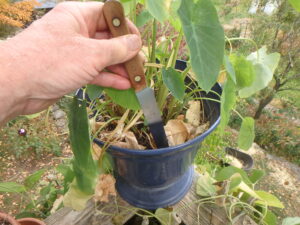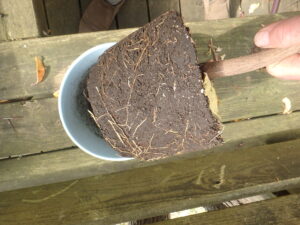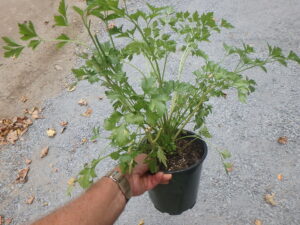Getting Houseplants and Herbs Ready for the Indoors
Posted on Tuesday, September 29, 2020 · Leave a Comment
Most of us bring our houseplants outside for the summer. Now is the time to bring them in, or get them ready to make the move. It’s also the time to put herbs that you’ve had in the ground all summer into pots and get them ready for winter use in the kitchen.
Generally, plants outdoors don’t suffer much from aphids: the pests are kept in check by good insects that munch on them. But move a plant indoors, and they often get covered with those tiny aphids and their honeydew, which makes a sticky mess of your leaves.
The solution is an easy one. Before bringing a potted plant indoors, wash the leaves. I do this by placing the potted plant on its side, and washing it with a stream of water from the hose. I wash not only the tops of the leaves, but the underside, too. Roll the pot twice to wash all the leaves well.
In addition to the leaves, I wash off the surface of the potting soil to get any eggs or aphids hiding there. I then add half an inch of fresh potting soil to replace any I washed off. Then I stand the pot up and let it dry in the sun. For smaller plants, you can wash them in the kitchen sink.
Although spring is generally recommended for re-potting houseplants, it may be needed now if a houseplant has been in the same pot for a long time. If roots are poking out of the holes in the bottom of the pot, or if the plant leaves are smaller than previously, it’s time to re-pot. You can remove a plant from its pot to see if roots are matted and tangled at the bottom of the root ball, and pressed up against the side of the pot.

A bread knife can help loosen soil attached to a flower pot
Getting a plant out of a pot is not always easy. If the pot is small enough, hold it upside down, give a tug on the plant and it will slide out into your waiting hand. For bigger pots I use a long bread knife or cake spatula and slide it between the root ball and the pot, poking and pushing all the way around the outer edge to loosen the soil. Then I turn it upside down again and try to remove it.
For big pots, get someone to help you. Hold the plant, and ask your helper to tug and rotate the pot, pulling until the plant comes out. Plastic and fiberglass pots are generally more willing to give up their grip on plants than old fashioned baked clay pots.

Loosen the soil by tickling these roots and you will have room for new soil
Once the plant is out of the pot, try to loosen up the roots. If they are a tightly tangled mess, you can use a serrated steak knife to cut off an inch or so of roots at the bottom of the pot. Roots on the sides can be “tickled” loose with your fingers, a kitchen fork, or a hand tool such as the CobraHead weeder. Let soil fall off the roots, as it is depleted and will be replaced.
Potting mix is generally based on peat moss, which is light and fluffy but not very nutritious for your plants. I like to mix it with high quality compost – my own, or purchased. I find Moo-Doo brand composted cow manure to be excellent, and readily available. It is made in Vermont.
I like to have an inch of two of my freshly made potting mix in the bottom of the pot, and half an inch to an inch of it all around the perimeter. To make space around the outside requires removing old soil – or using a slightly bigger pot
When adding soil mix around the outside of the pot, use your fingers to push the new mix down, but you may need a wooden spoon or paint stirrer to get it all the way to the bottom of the pot. Water after the job is done to be sure no air pockets are left in the pot.

Parsley roots are long and need a deep pot
Some perennial herbs can be moved inside for the winter. These include chives, rosemary, thyme and parsley. Parsley has many deep roots, so an eight-inch deep pot is best. Chives are easy to pot up, and do well on a bright window sill. I will cut mine back in a week, as she looks a bit like Rapunzel now. Basil, no matter how hard we try, is not a good candidate to come inside. It attracts aphids and needs more light than a windowsill will normally provide. I’m going to try moving some dill inside this year, but have not previously tried it.
After you have potted up some herbs, leave them outside for a week or more. Why? It’s best to change just one variable at a time. There is always less light inside, so let the plants get used to being in a pot before moving them indoors. Be sure not to over-water your herbs: most are Mediterranean in origin, and do best in relatively dry soil. That said, please know that a completely dry rosemary is a dead rosemary.
On another note, a few days after a hard frost you should dig up your dahlias, calla lilies, gladiolas and cannas. Store them in a cool, dark place. A brown paper bag with some slightly damp wood shavings used in gerbil cages or sphagnum moss will keep them from drying out too much.
Henry can be reached at
henry.homeyer@comcast.net. He is the author of 4 gardening books, and is gardening consultant and long time UNH Master Gardener.





